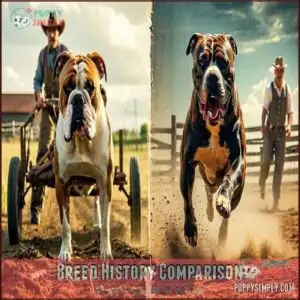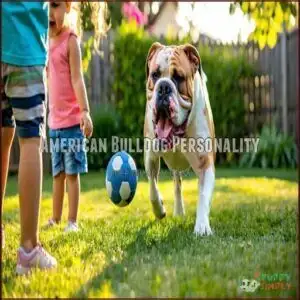This site is supported by our readers. We may earn a commission, at no cost to you, if you purchase through links.

While both breeds share bull-baiting ancestry, American Bulldogs have broader heads and more muscular builds.
Pitbulls typically have more energy and need consistent exercise, while American Bulldogs can be slightly more protective of their families.
Both breeds are loyal companions who’ve unfairly gotten a bad rap—their temperament depends mostly on how you raise and train them.
The right choice between an American Bulldog vs Pitbull often comes down to which personality matches your lifestyle and the space in your home, considering factors like energy levels and living situation to find the best breed for your needs.
Table Of Contents
- Key Takeaways
- Breed History Comparison
- Physical Characteristics
- Temperament Differences
- Health and Grooming Needs
- Choosing The Right Breed
- Frequently Asked Questions (FAQs)
- Is an American Bulldog the same as a Pitbull?
- Who is stronger, a Pitbull or a bulldog?
- Are American Bulldogs a restricted breed?
- How do I know if my dog is a Pitbull or an American Bulldog?
- Are American Bulldogs the same as Pitbulls?
- What is the difference between a pit bull and a bulldog?
- What is the difference between pit bull and American Bully?
- Are American Bulldogs better than pit bull terriers?
- Are American Bulldogs more aggressive than Pitbulls?
- Are American pit bull terriers American Bulldogs?
- Conclusion
Key Takeaways
- You’ll find American Bulldogs are significantly larger than Pitbulls, weighing up to 120 pounds compared to Pitbulls’ maximum of 60 pounds, with broader chests and more facial wrinkles.
- Both breeds share bull-baiting ancestry but followed different paths—American Bulldogs were bred for farm work and protection while Pitbulls emerged from crossing bulldogs with terriers for agility and strength.
- You’ll need to match your dog’s energy level with your lifestyle, as Pitbulls typically require more daily exercise (2+ hours) than American Bulldogs (1-2 hours) and have higher mental stimulation needs.
- Despite misconceptions about aggression, both breeds can be loving family companions when properly trained and socialized, with temperament depending more on upbringing than breed-specific traits.
Breed History Comparison
You’ll find that American Bulldogs and Pitbulls share roots from the Old English Bulldog but followed different paths to become the breeds we recognize today.
While American Bulldogs were bred for farm work and protection in the 1800s, Pitbulls emerged from crossing bulldogs with terriers for their agility and strength, which showcases the distinct breeding purposes of each.
American Bulldog Origins
The ancient bloodline of American Bulldogs traces back to mastiffs that originated in Asia.
You’ll discover their direct ancestors were the working English Bulldogs brought to North America by settlers in the 17th century.
| Time Period | Key Development | Impact |
|---|---|---|
| Colonial Era | Brought to American colonies | Farm utility work |
| Southern U.S. | Development of four key strains | Johnson, Scott, Bailey & Williamson |
| Post-WWII | Near extinction & revival | Saved by Johnson and Scott |
These hardy farm dogs nearly disappeared after World War II but were rescued through the dedicated breeding efforts of John D. Johnson and Alan Scott.
As a breed, they’re considered guardian type dogs.
Pitbull Origins
Emerging from 1800s UK development, the Pitbull stems from English crossbreeding between Old English Bulldogs and Terriers.
The fierce elegance of Pitbulls emerged from Victorian England’s calculated cross between bulldogs and terriers—power meeting precision.
You’ll find the term "pit" comes from ratting competitions where dogs competed in pits.
The American Pit Bull Terrier gained official breed recognition in 1898 by the United Kennel Club.
| Timeline | Event | Purpose |
|---|---|---|
| Early 1800s | Bull-baiting History | Blood sport entertainment |
| 1835 | UK Banned Blood Sports | Led to ratting and dogfighting |
| 1860s | Bull and Terrier Development | Enhanced speed and agility |
| 1898 | UKC Breed Recognition | Official breed status |
The development of the breed is closely tied to its blood sport entertainment history, which includes bull-baiting and eventually led to the UKC Breed Recognition.
Shared Ancestry
Despite their distinct development paths, both breeds share the same family tree.
The Old English Bulldog serves as the common ancestor from which these powerful canines evolved.
Their shared bull-baiting history eventually split when terrier influence created distinct breed development paths.
| Breed Development | Ancestry Component | Time Period |
|---|---|---|
| American Bulldog | Pure Old English Bulldog | 1800s |
| Pitbull | Bull and Terrier cross | Early 19th century |
| Modern Recognition | Different breed standards | 20th century |
You’ll find their blood runs thick with history, though their journeys took separate turns, influenced by their distinct breed standards and powerful lineage.
Historical Uses
Both breeds rolled up their sleeves for different jobs throughout history.
While sharing bull-baiting origins, they later took different paths.
| Time Period | American Bulldog | Pitbull |
|---|---|---|
| 1800s | Farm utility, protection | Dogfighting, rat baiting |
| Early 1900s | Feral pig control | Police work, farming |
| Mid-1900s | Near extinction | Military service |
| Today | Family companions | Therapy, service dogs |
You’ll find the American bulldog’s history particularly fascinating for its role in controlling wild hogs across the Southern United States.
Physical Characteristics
You’ll notice the difference between American Bulldogs and Pitbulls the moment they stand side by side.
American Bulldogs are larger with a broader chest and facial wrinkles, while Pitbulls have a leaner, more athletic build with a defined jawline.
American Bulldog Size and Build
While both breeds share bulldog ancestry, their physical structures couldn’t be more different.
Though cousins by blood, American Bulldogs and Pitbulls wear their shared ancestry in remarkably different physical frames.
American Bulldogs are truly imposing dogs. You’ll immediately notice their substantial size, weighing between 60-120 pounds and standing 20-28 inches tall.
Their body is built like a tank with:
- A massive, broad chest that gives them their distinctive powerful stance
- Thick, muscular shoulders that highlight their impressive strength
- A square, blocky frame that shows off their bulldog heritage
Pitbull Size and Build
Unlike their bulkier cousins, Pitbulls showcase a leaner, more athletic build.
Your American Pit Bull Terrier will typically stand 17-21 inches tall and weigh a moderate 35-60 pounds.
Their body proportions feature well-defined muscle definition and a narrower frame.
When comparing bulldog vs pitbull size, you’ll notice Pitbulls have that distinctive V-shaped head and more pronounced athletic ability, making them nimble and agile companions.
Coat Colors and Patterns
When you look at these breeds side by side, their coat colors and patterns tell different stories.
American bulldogs typically sport white coats with patches of black, brown, or brindle.
Pitbulls showcase a wider palette, featuring up to 20 color variations from solid black to red, with unique "tuxedo" patterns (lighter belly coloring).
Color genetics play a significant role in these differences, with pattern variations making each dog distinctly recognizable, highlighting the importance of color genetics.
Facial Features
One glance at these dogs’ faces tells you everything.
American bulldogs have broader heads with prominent wrinkles and often sport an underbite. Their muzzle is shorter with impressive jaw strength.
Pitbulls showcase a more defined V-shaped head, longer muzzle length, and fewer facial wrinkles.
Eye shape differs too – bulldogs have rounder eyes while pitbulls typically display almond-shaped eyes with a more alert expression, which is a key distinguishing feature, including their prominent wrinkles and broader heads.
Temperament Differences
You’ll notice significant differences in how American Bulldogs and Pitbulls behave around your family and other pets.
While both breeds are loving and energetic, American Bulldogs tend to be more reserved with strangers and moderately friendly with other pets.
Pitbulls typically show higher trainability but require more careful introduction to other dogs.
American Bulldog Personality
In the case of American Bulldog personality, you’ll find a breed that excels in loyalty and affection.
These powerful dogs combine assertive confidence with playful energy, making them excellent family dogs.
They’re naturally protective of their owners but remain calm and affable around the house.
With proper socialization, American Bulldogs show remarkable self-confidence while maintaining their loving nature.
Their bravery is balanced by their deep devotion to family.
Pitbull Personality
While American Bulldogs show strong family loyalty, Pitbulls take affection to a whole new level.
These misunderstood dogs offer incredible Pitbull affection, often becoming velcro companions. You’ll find their Pitbull personality combines intelligence with a desire to please.
Though they’ve earned an unfair reputation for aggression, properly socialized Pitbulls are typically devoted, gentle, and surprisingly sensitive.
Early socialization for puppies is essential to temper any potential aggressive tendencies.
They’re people-oriented couch potatoes who’ll shower you with love and loyalty.
Trainability and Intelligence
While both breeds show remarkable loyalty, their approaches to training differ substantially.
Pitbulls often edge out American bulldogs in intelligence and learning speed, though both can master commands with consistent practice.
Here’s how these breeds compare in the smarts department:
- Pitbulls typically learn new commands in 5-15 repetitions
- American bulldogs may need 15-25 repetitions for the same tasks
- Pitbulls excel at problem-solving challenges
- American bulldogs show stronger independent thinking
- Both breeds respond best to positive reinforcement training methods
Energy Levels and Exercise Needs
Now that you understand their trainability differences, let’s talk about what these dogs need activity-wise.
You’ll find significant differences in the energy levels between these powerful breeds. While both need regular exercise, they differ in intensity and duration.
Many owners choose to invest in specialized training tools for their Pitbulls.
| Aspect | American Bulldog | Pitbull |
|---|---|---|
| Daily exercise | 1-2 hours | 2+ hours |
| Exercise intensity | Moderate | High |
| Mental stimulation | Moderate needs | High needs |
| Puppy energy | Bursts of activity | Seemingly endless |
These dogs have distinct needs when it comes to daily exercise and mental stimulation, which is crucial for their development and happiness.
Health and Grooming Needs
You’ll need to understand both breeds’ health concerns and grooming routines to keep your furry friend in top shape.
Whether you’re caring for an American Bulldog or a Pitbull, knowing their specific needs will help you prevent common issues and maintain their distinctive appearance.
Common Health Issues in American Bulldogs
While both breeds have distinct personalities, their health profiles differ substantially.
Your American bulldog may face several serious health challenges throughout its life:
- Hip and elbow dysplasia can cause pain, lameness, and mobility issues
- Skin allergies often manifest as itchy, red, or flaky patches
- Eye problems like cherry eye are common, with white bulldogs more prone to blindness
Regular vet check-ups help catch these issues early, preventing your furry friend from suffering needlessly, and this is crucial for maintaining their overall health.
Common Health Issues in Pitbulls
Regarding Pitbull health issues, you should be aware of several common conditions.
Your Pitbull may develop hip dysplasia, which affects their mobility, or skin allergies that cause itching and irritation.
They’re also prone to heart disease, eye problems like cataracts, and other genetic health conditions.
Regular vet check-ups can help catch these issues early, giving your four-legged friend the best chance at a healthy life.
Grooming Requirements
You’ll find grooming both American Bulldogs and Pitbulls surprisingly manageable.
Both breeds have short coats requiring weekly brushing to control shedding. Bath frequency can be kept to every 4-6 weeks unless they get particularly dirty.
Don’t forget regular nail trimming, ear cleaning, and skin care checks—especially in skin folds for Bulldogs. Proper care requires specialized bulldog supplies.
Pitbulls typically need less intensive skin care than their Bulldog cousins, and they also require regular grooming to stay healthy.
Importance of Regular Veterinary Check-Ups
Beyond grooming, both American bulldogs and Pitbulls need regular vet visits for early detection of breed-specific health issues.
Your dog’s vaccination schedules should be kept up-to-date, while routine parasite control prevents heartworm and tick-borne diseases.
Don’t forget dental health—both breeds can develop gum disease.
Preventative care catches problems before they become serious, saving you money and keeping your four-legged friend healthier longer.
A good way to streamline this is to designate a pet care station for essentials, which helps with preventative care and ensures regular vet visits for a healthier pet.
Choosing The Right Breed
You’ll need to match your lifestyle with the right breed to make the best choice between an American Bulldog and a Pitbull.
Whether you live in an apartment or have a large yard, understanding each breed’s size, energy level, and temperament will help you find your perfect four-legged companion.
Lifestyle Considerations
Now that you understand both breeds’ health needs, let’s look at how they fit your lifestyle.
Your activity level matters—Pitbulls need 1-2 hours of daily exercise, while American Bulldogs require slightly less.
Consider your family situation too, as both make excellent family dogs but have different training needs.
Remember breed restrictions in some housing communities and the cost implications of owning these energetic pups.
Living Situation Factors
Now that you’ve weighed lifestyle factors, your living space plays a major role in choosing between an American Bulldog and Pitbull.
Your home environment impacts which breed will thrive with you. The key factors to consider include:
- American Bulldogs need more square footage due to their larger size, making them less apartment-suitable than Pitbulls
- Both breeds struggle in extreme climates but Pitbulls handle heat better
- Noise-sensitive neighbors? Consider that American Bulldogs tend to bark more than Pitbulls
Prospective owners must consider puppy ownership costs for long-term financial planning.
Researching Reputable Breeders
Finding a responsible breeder is like finding a treasure in a sea of options.
When researching reputable breeders for American Bulldogs or Pitbulls, focus on these key factors:
| Breeding Aspect | American Bulldog | Pitbull |
|---|---|---|
| Genetic testing | Hip/elbow evaluations | Heart/patella screening |
| Health certifications | OFA certification | BAER hearing tests |
| Breeder experience | Working dog background | Temperament expertise |
| Facility conditions | Clean, spacious kennels | Home-raised preferred |
Look for ethical breeding practices including transparent health records and proper socialization of puppies, which is crucial for the well-being of the dogs, and also consider proper socialization as a key factor.
Importance of Proper Training and Socialization
The keys to a well-adjusted dog lie in proper training and socialization.
Both American bulldogs and Pitbulls require early socialization to prevent behavioral problems. You’ll need consistent training with positive reinforcement techniques that address their breed-specific needs.
These powerful dog breeds thrive when they understand boundaries and expectations. Consider electronic collar options for advanced training.
Just remember, the time you invest in training today creates the companion you’ll enjoy tomorrow, and it’s essential for their development and your relationship with them, built on proper training.
Frequently Asked Questions (FAQs)
Is an American Bulldog the same as a Pitbull?
Chalk and cheese, these two breeds aren’t the same.
American Bulldogs are larger (60-120 pounds) with broader heads, while Pitbulls are smaller (35-60 pounds) with more athletic builds.
They share bulldog ancestry but differ substantially in terms of their physical characteristics, making them distinct, with American Bulldogs being a notable example.
Who is stronger, a Pitbull or a bulldog?
American Bulldogs are typically stronger than Pitbulls due to their larger size and more muscular build.
You’ll notice Bulldogs weigh 60-120 pounds compared to Pitbulls at 35-60 pounds, giving them a strength advantage.
Are American Bulldogs a restricted breed?
Isn’t it ironic that your furry friend faces legal scrutiny?
Yes, you’ll find American Bulldogs are restricted in several states including Arkansas, Colorado, Missouri, Nebraska, and New Mexico through breed-specific legislation (BSL).
How do I know if my dog is a Pitbull or an American Bulldog?
Look at size first—Pitbulls are smaller (35-60 pounds) with athletic builds, while Bulldogs are larger (60-100 pounds) with broader chests and facial wrinkles.
Check coat patterns too—Bulldogs often have white with patches, which can be a key distinguishing feature between the breeds.
Are American Bulldogs the same as Pitbulls?
No, they’re not the same.
You’ll find distinct differences in size, build, and ancestry.
American Bulldogs are larger with broader chests, while Pitbulls are smaller, more athletic, and have different breed recognition standards, which highlights their distinct differences.
What is the difference between a pit bull and a bulldog?
Pit bulls are smaller, leaner dogs weighing 35-60 pounds with athletic builds, while bulldogs are larger, stockier animals weighing 60-100 pounds with broader chests and more facial wrinkles.
You’ll notice their distinct body shapes immediately.
What is the difference between pit bull and American Bully?
American Bullies are stockier with broader shoulders and more muscle mass than Pit Bulls.
You’ll notice they’re shorter with wider chests, while Pit Bulls are leaner, more athletic, and typically stand taller.
Are American Bulldogs better than pit bull terriers?
Two sides of the same coin, neither breed is inherently "better."
Your lifestyle, experience, and preferences matter most.
American Bulldogs are larger and calmer, while pit bulls are smaller and more energetic.
Are American Bulldogs more aggressive than Pitbulls?
Neither breed is inherently more aggressive than the other.
Aggression in any dog depends more on training, socialization, and responsible ownership rather than breed-specific traits.
You’ll find friendly examples of both breeds.
Are American pit bull terriers American Bulldogs?
Despite common confusion, American Pit Bull Terriers aren’t American Bulldogs.
They’re entirely different breeds sharing bulldog ancestry.
You’ll notice Pit Bulls are smaller with terrier traits, while Bulldogs have a stockier, more massive build, which highlights their distinct physical characteristics as separate breeds with terrier traits.
Conclusion
Choosing between an American Bulldog vs Pitbull is like selecting the perfect pair of shoes—comfort and fit matter most.
Whether you prefer the larger, more protective American Bulldog or the energetic, compact Pitbull, both breeds offer unwavering loyalty when properly trained.
You’ll find either can thrive in your home with consistent exercise, proper socialization, and lots of love.
Remember, it’s not just about appearances—your lifestyle and commitment will determine which breed becomes your perfect companion.

















